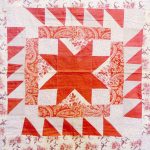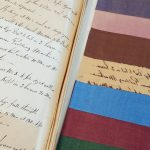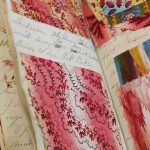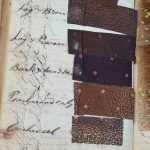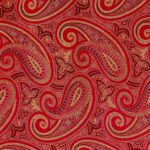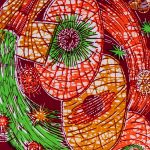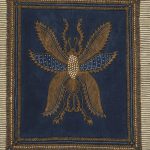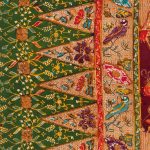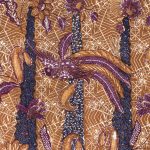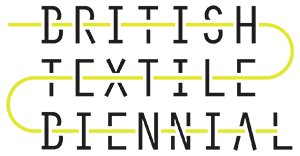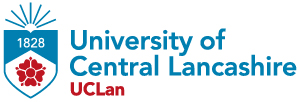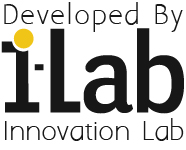This small patchwork coverlet is probably a cot cover and has been made by piecing without paper templates. The design has a frame layout, where concentric borders frame a central panel. Squares, strips and triangles have been used to create several different borders including examples of the patterns ‘tree everlasting’ or ‘flying geese’ and saw […]
View moreThis book comes from Rosebank Mill in Lancashire and dates from 1832. The inside cover features the name Bennet Greig and the name of the mill and the date 25th September 1832. It contains an array of printed dress and furnishing fabrics along with detailed notes about their production. Within the pages are examples of […]
View moreThis book contains mostly printed cotton dress fabrics with a few examples of larger scale prints labelled as ‘furnitures’, which would have been used as household furnishings such as upholstery or curtains. Many of the fabric samples showcase the adoption of innovative new developments in printing technology from the early 19th century. One of the […]
View moreThis book comes from Rosebank Mill in Lancashire and contains samples of mainly dress fabrics. Most of the samples are printed on smooth, evenweave cotton although there is one sample of cotton with a ribbed pile like corduroy. The cover bears the name Thomas Comstive and indicates that the book covers the period “1832 and […]
View moreExploring the connections between two iconic dyes and the story of William Gatty and his home; Elmfield Hall in Accrington.
View moreThis sample is one of a set of over 90 print samples attributed to the Robert Hindle & Co Print Works in Sabden, Lancashire. The vibrant colours of the samples are a perfect example of the impact that aniline dyes had on the dyeing and printing industries. The first aniline dye was mauveine or ‘Perkin’s […]
View moreThis sample is one of a set of over 90 print samples attributed to the Robert Hindle & Co Print Works in Sabden, Lancashire. The vibrant colours of the samples are a perfect example of the impact that aniline dyes had on the dyeing and printing industries. The first aniline dye was mauveine or ‘Perkin’s […]
View moreA millennium ‘guaranteed wax’ calendar for the year 2000 from the ABC Wax company, which has links to Greater Manchester to this day. The company began with a printworks which opened in Hyde in the early 19th century. In 1908 they began to produce the exact kind of fabric we see here – imitation batik […]
View moreThese panels from Indonesia or Borneo show the fourteen stages of the batik method required to make this relatively simple design of a beetle using blue and brown dyes. A more detailed design and wider range of colours would add many more steps to the process and require even more patience and skill to create. […]
View moreThe elaborate pattern and vibrant colours of this Malaysian batik sarong would have required a great deal of skill to create and the finished garment would have been a status symbol for the wearer. The complex design features peacocks as well as other birds, butterflies and a variety of floral motifs. At least six different […]
View moreThis intricately patterned sarong from Indonesia is a beautiful example of the batik method. The complex design features birds, spiders, beetles and other insects worked in shades of deep blue and brown. Each colour would require a new layer of wax to be laid over the relevant sections of fabric, dyed, then washed free of […]
View moreThis commercial sample was designed and manufactured in Lancashire using industrial printing processes to closely imitate the effect of a traditional, hand worked batik or wax resist dyeing. The design features a simple colour palette with geometric patterns as the backdrop for large and graphic fish motifs. Resist-dyeing is an ancient process and flourished in […]
View more